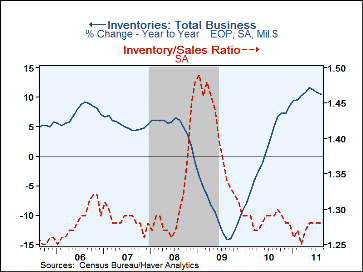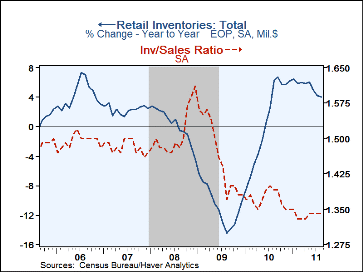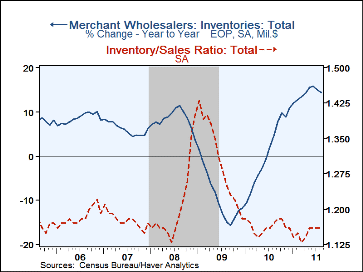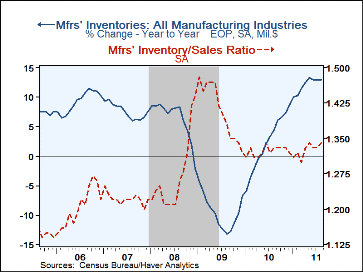 Global| Oct 14 2011
Global| Oct 14 2011U.S. Business Inventory Growth Holds Steady
by:Tom Moeller
|in:Economy in Brief
Summary
The U.S. Commerce Department reported that business inventory growth held steady in August at 0.5%. A 0.4% increase was expected and July was revised from 0.4%. Business sales increased a moderated 0.3%. As a result, the [...]
The U.S. Commerce Department reported that business inventory growth held steady in August at 0.5%. A 0.4% increase was expected and July was revised from 0.4%. Business sales increased a moderated 0.3%. As a result, the inventory/sales ratio held at 1.28. By August, inventories were 10.5% higher than August 2010, and sales were up 11.8%.
In the retail sector, the 0.8% gain in inventories was the strongest since March as was the 0.6% nonauto increase. Motor vehicle & parts inventories were strongest with a 1.5% gain (3.4% y/y) while clothing & accessory inventories rose 1.2% (8.1% y/y). Inventories of general merchandise rose 0.3% (3.4% y/y) while furniture slipped 0.1% (-0.3% y/y). Inventory/sales ratios held low.
The manufacturing and trade data are in Haver's USECON database. Note that in a value-added feature, the database includes series calculated by Haver database managers showing sales, inventories and I/S ratios for total business less motor vehicle dealers and related wholesale operations. The latest gain in inventories compared to an expected 0.4% increase according to Bloomberg.
|
Business Inventories (%) |
Aug | Jul | Jun | Aug Y/Y | 2010 | 2009 | 2008 |
|---|---|---|---|---|---|---|---|
| Total | 0.5 | 0.5 | 0.4 | 10.5 | 8.6 | -9.3 | -1.2 |
| Retail | 0.8 | 0.1 | 0.2 | 4.1 | 6.1 | -10.0 | -4.4 |
| Retail excl. Motor Vehicles | 0.6 | -0.1 | 0.2 | 4.3 | 3.7 | -4.7 | -3.0 |
| Merchant Wholesalers | 0.4 | 0.8 | 0.6 | 14.4 | 11.0 | -11.8 | 3.7 |
| Manufacturing | 0.4 | 0.6 | 0.4 | 12.9 | 8.7 | -6.8 | -4.1 |
| Business Sales (%) | |||||||
| Total | 0.3 | 0.7 | 0.5 | 11.8 | 9.3 | -14.6 | 2.3 |
| Retail | 1.1 | 0.3 | 0.5 | 8.1 | 6.8 | -7.8 | -1.6 |
| Retail excl. Motor Vehicles | 0.5 | 0.5 | 0.4 | 8.0 | 6.1 | -6.3 | 2.1 |
| Merchant Wholesalers | 1.0 | 0.3 | 0.6 | 15.2 | 12.6 | -16.1 | 5.9 |
| Manufacturing | -0.2 | 1.2 | 0.6 | 12.1 | 8.6 | -18.5 | 2.3 |
| I/S Ratio | |||||||
| Total | 1.28 | 1.28 | 1.28 | 1.29 | 1.28 | 1.39 | 1.32 |
| Retail | 1.34 | 1.34 | 1.34 | 1.39 | 1.37 | 1.46 | 1.51 |
| Retail Excl. Motor Vehicles | 1.19 | 1.19 | 1.19 | 1.23 | 1.23 | 1.30 | 1.29 |
| Merchant Wholesalers | 1.16 | 1.16 | 1.16 | 1.17 | 1.16 | 1.30 | 1.21 |
| Manufacturing | 1.34 | 1.33 | 1.33 | 1.33 | 1.33 | 1.41 | 1.27 |
Tom Moeller
AuthorMore in Author Profile »Prior to joining Haver Analytics in 2000, Mr. Moeller worked as the Economist at Chancellor Capital Management from 1985 to 1999. There, he developed comprehensive economic forecasts and interpreted economic data for equity and fixed income portfolio managers. Also at Chancellor, Mr. Moeller worked as an equity analyst and was responsible for researching and rating companies in the economically sensitive automobile and housing industries for investment in Chancellor’s equity portfolio. Prior to joining Chancellor, Mr. Moeller was an Economist at Citibank from 1979 to 1984. He also analyzed pricing behavior in the metals industry for the Council on Wage and Price Stability in Washington, D.C. In 1999, Mr. Moeller received the award for most accurate forecast from the Forecasters' Club of New York. From 1990 to 1992 he was President of the New York Association for Business Economists. Mr. Moeller earned an M.B.A. in Finance from Fordham University, where he graduated in 1987. He holds a Bachelor of Arts in Economics from George Washington University.










